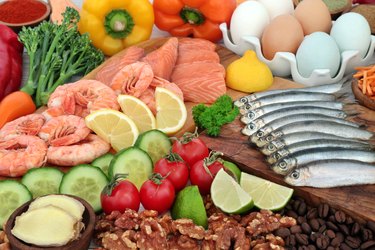
If you're wondering how to lose breast fat specifically, it isn't possible to shrink your breasts alone. However, full-body weight loss from lifestyle changes like diet and exercise may also help you lose breast weight.
Breasts contain glandular tissue — which makes up the lobes and ducts that produce milk — and fatty tissue that fills in the extra space, per the Memorial Sloan Kettering Cancer Center (MSKCC). It's the fatty tissue that largely determines your breast size, and the amount of fat you carry in your breasts is different for everybody based on factors like your hormones, age and natural body weight fluctuations, according to the Mayo Clinic.
Video of the Day
Video of the Day
You can have healthy breasts at any size. But for some, larger breasts may put excess strain on your spine and back muscles, which can cause neck, back and shoulder pain, per the Mayo Clinic.
If shrinking your boobs is your goal, here's how to lose weight in your breasts.
1. Diet
Wondering how to lose boob fat specifically? While you can't target weight loss in your breasts alone, losing weight throughout your body may help.
And eating a balanced diet is a key part of any weight-loss endeavor, whether you're aiming to reduce boob fat or otherwise. Per the Mayo Clinic, your daily meals should include nutrients and foods such as:
- Fiber-rich fruits and vegetables
- Whole grains like whole-wheat bread, barley and brown rice
- Sources of protein, including nuts, eggs, fish and lean meat like chicken
- Beneficial fats, including those found in nuts, olive oil, avocado and dairy products like yogurt
On the flip side, limit foods such as:
- Refined carbohydrates like white bread and breakfast cereals
- Foods with added sugars like baked goods, soda and condiments
- Foods with trans or saturated fats like red meat, butter and certain cheeses
It's also important to create a daily calorie deficit to help you lose weight, according to the Mayo Clinic. Reducing your intake by 500 to 1,000 calories a day will typically help you lose weight — including breast fat — at the safe and sustainable pace of about 1 to 2 pounds per week.
Warning
Calorie intake should not fall below 1,200 per day for people assigned female at birth or 1,500 per day for people assigned male at birth, except under the supervision of a doctor, per Harvard Health Publishing. That's because eating too few calories can deprive you of essential nutrients.
2. Exercise
It's also important to exercise regularly if you're trying to lose weight and shrink your breast size naturally. The Physical Activity Guidelines for Americans recommend adults do 150 minutes of moderate aerobic activity (or 75 minutes of intense cardio) and at least two strength training sessions per week.
Aerobic exercise can contribute to your daily caloric deficit to help you lose weight throughout your body, including in your boobs. And that's not the only benefit of cardio — aerobics can also support heart health, brain health and better sleep for your overall wellbeing. Try cardio activities like:
- Walking
- Running
- Cycling
- Swimming
- Rowing
- Dancing
- Boxing
And while your breasts don't contain muscle themselves, weight training can strengthen the pectoral muscle that lies behind your breasts and supports them, per the MSKCC. Dabble in different types of strength training, including:
Tip
Doing chest exercises like push-ups or presses won't make your boobs shrink, but it can contribute to full-body strength and overall weight loss, according to the American Council on Exercise.
3. Binding
Though it won't help you lose breast weight, binding your chest may help you visually reduce the size of your breasts if you have gender dysphoria, according to the Mayo Clinic. Per the Cleveland Clinic, you can flatten your chest with the following methods:
- Wearing several sports bras
- Layering clothing
- Using kinesiology tape
- Wearing a commercial chest binder
However, binding your breasts too tightly or with non-breathable fabric may cause discomfort, pain, acne or skin infection, according to the Cleveland Clinic. Bind safely with the following tips:
- Wear a binder made of breathable material
- Keep cool to avoid letting sweat collect under your binder
- Take time off from wearing your binder, like when you sleep or when you're at home
Tip
Talk to your doctor to determine the best binder for you, how often you should use it and how to avoid side effects.
4. Breast Reduction Surgery
Surgery is another way to reduce breast size if your breasts cause severe symptoms that interfere with your daily life, like pain or postural issues. If this is the case for you, talk to your doctor about a breast reduction surgery to decrease breast tissue, or other alternatives like over-the-counter pain relief or physical therapy.
A mammoplasty (the technical term for a breast reduction) removes excess fat and glandular tissue to shrink your breast size and relieve neck, shoulder or back pain, explains the American Society for Plastic Surgery.
But remember: Any surgery is invasive and carries risks, so be sure to cover any concerns in a thorough discussion with your doctor.
- Memorial Sloan Kettering Cancer Center: "Anatomy of the Breast"
- Mayo Clinic: "Female breast anatomy"
- Mayo Clinic: "Breast pain"
- Harvard Health Publishing: "Calorie counting made easy"
- Mayo Clinic: "Follow the Healthy Weight Pyramid"
- Mayo Clinic: "Counting calories: Get back to weight-loss basics"
- U.S. Department of Health and Human Services: "Physical Activity Guidelines for Americans, 2nd Edition"
- American Society for Plastic Surgery: "What is breast reduction surgery?"
- American Council on Exercise: "Myths and Misconceptions: Spot Reduction and Feeling the Burn"
- Mayo Clinic: "Gender dysphoria"
- Cleveland Clinic: "How to Bind Your Chest Safely"
Is this an emergency? If you are experiencing serious medical symptoms, please see the National Library of Medicine’s list of signs you need emergency medical attention or call 911.